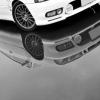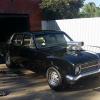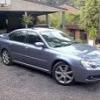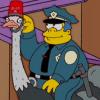
How Gearboxes Work
#1

Posted 16 October 2008 - 12:08 PM
----------------------------------------------
For those of you who have an understanding of how transmissions actually work, this technical sidebar will probably leave you intellectually flaccid. For the remaining 99.9% of us who assume that all those spinning gears, shafts, sliders and dog teeth mystically work together, following no comprehensible rhyme or reason, this document will probably confirm your suspicions.
Quite frankly, if the person who designed the first multi-gear transmission was a bright engineer, the fellow who built the first multi-gear, multi-differential, all-wheel drive transmission must have had a brain the size of a mutated watermelon. Here's why: One side of the system, we have an engine that spins in only one direction. On the other end are four wheels that can spin at different speeds and in different directions. In the middle, we have six gears (five forward and one reverse) and three limited slip differentials (front, center and rear), providing for limitless possible torque transfer scenarios. All of these components work together fluently and make up what is perhaps one of the most compact, complicated and reliable (assuming one doesn't turbocharge the pee out of it) transmissions in the entire automotive kingdom.
How exactly does this all work? Let's start from the first component in the chain of confusing torque transfer: the engine. As we all know, the engine sucks in fuel and air, squeezes the charge, ignites a well-timed spark and converts the force of expanding gases into rotational motion. Connected to the backside of the engine is a clutch, which is designed to engage and disengage the transmission input shaft by the push of a pedal. When engaged, the input shaft spins at the same speed as the engine. On the input shaft are five gears (ignoring reverse). The smallest gear is first. The largest is fifth. Running side by side with the input shaft, and also equipped with five complementary gears, is the output shaft, which is aptly named because its role is to transfer torque from the gears to the driveshaft.
Okay, so know we know that both the input and output shafts have five gears sets¡ªten gears in all. What some may not be aware of is that each gear set is engaged at all times. In other words, there is no sliding around of gears during the enjoyable process of shifting. But one may ask, " If all gears are constantly engaged, how does one select one gear at a time?" Good question. One that can only be answered when one understands that the gears and shafts can spin independently of each other¡ well, sort of. In most transmissions, the gears on the output shaft are mounted on roller bearings while the gears on the input shaft are solidly fixed. In the case of the Nissan Pulsar GTi-R transmission, the OE engineers chose to be a little creative by only mounting third, forth and fifth gear of the input shaft on oil bearings (with the PAR ½ dog it uses needle roller bearings), leaving first and second gear fixed to the input shaft. On the output shaft, however, first and second are mounted on oil bearings while the others are fixed. In simple terms, the free-spinning gear duties were split up between the two shafts. But for the sake of simplicity, let's forget all this Nissan-specific wackiness and assume that all the gears on the input shaft are fixed while all the gears on the output shaft are freewheeling
Now imagine that the output shaft, with all of its fixed gears, is spinning at a typical idle speed of 900rpm. And where there is spinning input shaft gears, there are spinning output shaft gears. But with all gears on the output shaft freewheeling independently of the output shaft, the output shaft, itself remains motionless. And since the output shaft isn't spinning, neither is the driveshaft. This is what happens when the transmission is set to neutral.
Okay, so how do we actually get the transmission in a gear? After all, it's no fun to idle motionless all day. Here's how: Next to each of the five output shaft gears is something known as "sliders." Unlike the gears on the output shaft, the sliders cannot rotate freely. In fact, they cannot rotate at all as they are splined to the output shaft. The only thing they can do is slide along the shaft. Their function is to act as a torque bridge between the gears and the output shaft. For example, when first gear is selected, the first gear slider (which, by the way, is also shared with second gear) slides towards the first gear. On the face of the slider are tiny engagement teeth that fit snuggly into tiny holes that are on the face of the first gear. With the first gear firmly locked into the slider, which is firmly connected to the output shaft, the output finally spins, rotating the driveshaft in the process. Finally, forward motion! This very same sequence of events happens with each of the five other gear selections. The only complication is reverse, which requires the assistance of a secondary idler gear that effectively changes the input rotation direction. Got that? But what makes those sliders move around? Simple. You do. When the driver rows through the gearbox, he directs long gear select forks to push around the appropriate slider.
Okay, so what's the deal with synchros? What the heck do they do? As one can imagine, trying to engage the slider's teeth onto fast spinning gears can make some terrible sounds. The purpose of the synchroniser rings is to allow the slider and the gear to make contact before the teeth actually engage. This initial contact effectively matches the rotational speeds between the two components by acting as a break to slow the gear down, eliminating the terrible grinding noises that would otherwise occur.
What gear lubricant should be used with the PAR gearsets?
A gear oil with a minimum SAE 75w-90 and API GL-5 is mandatory. A GL-6 rated gear oil is preferable. All lubricants must have a viscosity index >160 with zero VI improvers. PAR's only recommended lubricants are NEO Synthetic 75w90HD(Synchromesh engagement transmissions) and NEO Synthetic 75w90RHD(Dog change transmissions) (API GL-2 thru GL-6). If other alternative lubricants are used, it is important that synchronizer safe products are used for synchromesh gearsets. Lubricants with a lower API rating such as GL-3 and GL-4 are not suitable because the aggressive tooth profile results in a contact area and mesh that quickly shears lower grade lubricants resulting in pitting, galling and eventual failure of the gearsets. The use of unapproved lubricants may void your gearset warranty. NEO Synthetic Lubricants can be purchased from Precision Automation & Robotics or online at GC Corp and Baker Precision.
Why do the big teeth of the gears break off well before the tiny engagement teeth of the gears and sliders?
This is because all of the slider's teeth engage at the same time, distributing torque equally between them all. On the gear, however, all the engine torque transferred between the input and output shafts are sent through one tooth at a time. So, looking at this further, helical cut gears would be stronger than straight cut gears of the same width as more than just one tooth will be transferring the torque.
Why did we get rid of the syncros and install dog gears? And more importantly, what the heck are "dog gears?"
If you have ever pulled apart your broken standard gearbox, you will see that the gears are quite narrow and the transmission is packed rather densely without much room to spare. As a result, if wider (which means-- all things equal-- stronger) gears are to be installed, somethings have got to go. And in our case, we opted for the synchro rings to go on the gears. The elimination of the synchros means that we have to do all of our input and output shaft speed matching ourselves uder normal driving conditions. As for dog gears, they are just another name for the engagement teeth of the sliders. However, in our case, the PAR designed engagement/dog teeth are massive and rather manly looking. So dog is the engagement style not the gear style.
Helical gears and Spur ( straight cut gears)
Spur gears have straight teeth and are used to contact parallel shafts. Spur gears a high pitch winning noise associated with them similar to the noise reverse gear generates.
Helical gears are used in standard factory transmissions. The teeth on Helical Gears lie along a helix, the angle of the helix being the angle betwwen the helix and the pitch cylinder element parallel with the gear shaft. Helical gears can connect either parallel or nonparallel nonintersecting shafts. Such gears are stronger and quieter than spur gears because the contact between mating teeth increases more gradually and more teeth are in contact at a given time.
Helical gears have one disadvantage when compared to spur gears. When they are loaded a side thrust is created that must be absorbed in the bearings.
Methods of Changing Gear.
The following is some info regarding shifting gear and face dog wear. I am in the fortunate position where I have a good amount of knowledge on the subject, as I understand the mechanical side and the user (driver) side equally well.
N.B. For succesful gear shifting, remember that it is critical to ensure that all mechanical elements between the drivers hand and the dog faces are in good order and properly set. This includes the gear linkage in the chassis!
Successful up-shifting, (defined as fast and non dog-damaging) will be achieved by fully moving the dog ring as rapidly as possible from one gear to the next, preferably with the engine's driving load removed until the shift is completed. (The opposite is true of a synchromesh gearbox as used in passenger cars, where slow movement helps). It should be remembered that it is not possible to damage the dogs when fully engaged (in gear). The damage can only take place when initiating contact during a shift, (the `danger zone`) therefore this element must be made as short as possible. If a driver moves the gear lever slowly, or if the linkage is not rigid and effective, dog wear will occur. We always recommend lightweight yet solid rod linkage, not cables ideally.
I list below the different methods of up-shifting that are used in racing most commonly. The best at the top, the worst at the bottom:
Automated (semi automated).
The movement of the dog ring is powered and the engine is cut / re-instated in a co-ordinated manner. Gear-shifts take milliseconds. This system produces zero dog wear when set up well. It is not applicable to most cars, but it illustrates that speed of shift is a good thing.
Manual with engine cut.
This system is almost as good as an automated one as long as the driver pulls the lever very quickly. Again it is not applicable to many cars, but it illustrates that speed of shift is a good thing. A `cheat` version of this is to shift on the engine rev limiter, which can work well. With this system it is especially important to move the lever ultra fast, otherwise the engine will be reinstated during partial dog engagement, causing damage. The damage can usually be felt by the driver.
Manual.
Best method: With no assistance from the engine management, the driver must lift off the throttle sufficiently to allow the dog ring to be pulled out of engagement. He should then stay off the throttle long enough to allow the dog ring to engage with the next gear. In practice, the driver can move the gear lever faster than he can move his foot off and back on to the throttle. Therefore the effective method is to apply load to the gear lever with your hand and then lift the throttle foot off and back on to the pedal as fast as physically possible. In lifting your foot, the loaded gear lever will almost involuntarily flick to the next gear before the foot is re-applied to the throttle.
Another method is to load the gear lever with your hand, stay flat on the throttle and dab the clutch to release the dog ring. The overall effect on the gear shift is similar to the above method, but clutch wear may become a big issue.
The worst method (most destructive and definitely slowest) is to attempt to change gear in a `passenger car / synchromesh` way, i.e. lifting off the throttle, dipping the clutch, moving the gear lever, letting the clutch up and re-instating the throttle. The method causes unnecessary clutch wear, does absolutely nothing to help come out of gear and usually causes dog wear whilst engaging the next gear. This wear is due to several reasons. Firstly, it is impossible for a driver to co-ordinate the complicated sequence of all five physical movements accurately. Consequently the engagement dogs often find themselves engaging whilst the throttle is applied. The lever is usually pulled more slowly as it was not pre-loaded, lengthening the `danger zone`.
Successful down-shifting, has similar rules applied regarding speed of shift. Unloading the dogs is done in the opposite manner obviously. Whilst braking, the dogs must be unloaded by either touching the throttle pedal or- my preferred method- by dipping the clutch. However, one sharp dab of clutch or
throttle is appropriate per shift. Continued pressure on either will cause dog damage for different reasons. `Blipping the throttle` just before engagement is advisable if the rev drops between gears are over 1300 rpm, as this will aid engagement and stabilise the car.
This is a subject which can be much expanded on, but I feel that these are the basics, which I hope are of use.
#2

Posted 16 October 2008 - 12:20 PM
#3

Posted 16 October 2008 - 12:36 PM
#4

Posted 16 October 2008 - 12:45 PM
former - 2000, Gen 3 - 2.5l RX Liberty, mods - Powerchip Gold 98, Borla extractors, Cat-back sports exhaust, Bilstein Suspension w/ Kings low's, Whiteline X\Heavy duty ADJ rear swaybar, Whiteline front Strut Brace, 6000k HID Xenons.
#5

Posted 16 October 2008 - 12:56 PM
#6

Posted 16 October 2008 - 01:52 PM
#7

Posted 16 October 2008 - 02:02 PM
former - 2000, Gen 3 - 2.5l RX Liberty, mods - Powerchip Gold 98, Borla extractors, Cat-back sports exhaust, Bilstein Suspension w/ Kings low's, Whiteline X\Heavy duty ADJ rear swaybar, Whiteline front Strut Brace, 6000k HID Xenons.
#8

Posted 16 October 2008 - 02:08 PM
#9

Posted 16 October 2008 - 02:32 PM
#10

Posted 16 October 2008 - 02:35 PM
#11

Posted 16 October 2008 - 02:37 PM
#12

Posted 16 October 2008 - 02:39 PM
#13

Posted 16 October 2008 - 02:52 PM
#14

Posted 16 October 2008 - 02:55 PM
#15

Posted 16 October 2008 - 04:12 PM
#16

Posted 16 October 2008 - 04:16 PM
LOL Banging 3rd? How, You would have to be doing over 100-110 perhaps even pushing 120 LOL! unless you are short shifting?
I get the shits because I never really get to use much of the rev range in anything above 1stSecond gear redline is around 115 I think?
Yup i've found around 105-110km/h for 3rd gear shift.
Ugh i could ramble on for forking days about this stuff.
#17

Posted 16 October 2008 - 04:41 PM
LOL Banging 3rd? How, You would have to be doing over 100-110 perhaps even pushing 120 LOL! unless you are short shifting?
I get the shits because I never really get to use much of the rev range in anything above 1stSecond gear redline is around 115 I think?
LOL, he has it on jack stands in the garage.
#18

Posted 16 October 2008 - 05:26 PM
#19

Posted 16 October 2008 - 05:28 PM
#20

Posted 16 October 2008 - 05:33 PM
0 user(s) are reading this topic
0 members, 0 guests, 0 anonymous users




















